DODGE RAM 2001 Service Repair Manual
Manufacturer: DODGE, Model Year: 2001, Model line: RAM, Model: DODGE RAM 2001Pages: 2889, PDF Size: 68.07 MB
Page 2111 of 2889
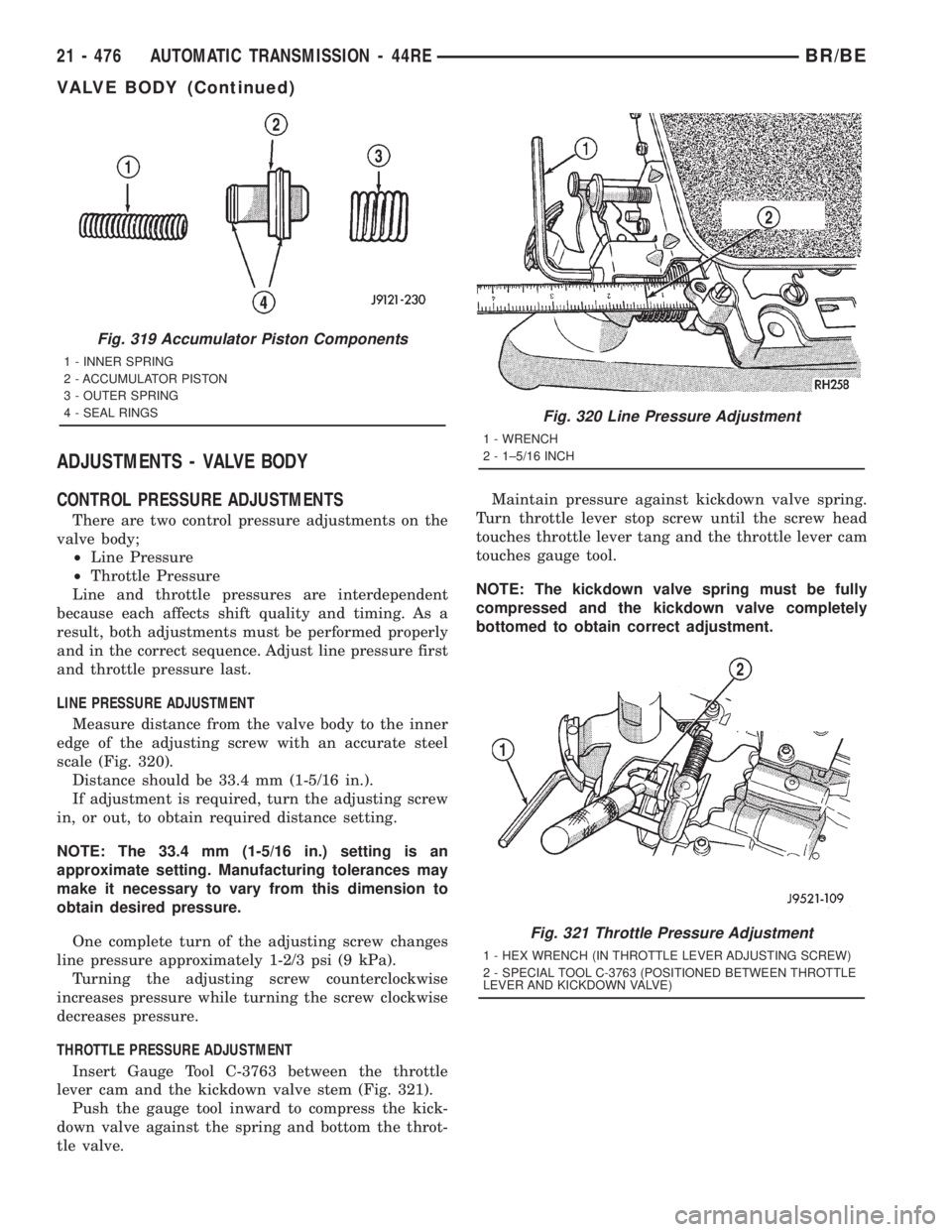
ADJUSTMENTS - VALVE BODY
CONTROL PRESSURE ADJUSTMENTS
There are two control pressure adjustments on the
valve body;
²Line Pressure
²Throttle Pressure
Line and throttle pressures are interdependent
because each affects shift quality and timing. As a
result, both adjustments must be performed properly
and in the correct sequence. Adjust line pressure first
and throttle pressure last.
LINE PRESSURE ADJUSTMENT
Measure distance from the valve body to the inner
edge of the adjusting screw with an accurate steel
scale (Fig. 320).
Distance should be 33.4 mm (1-5/16 in.).
If adjustment is required, turn the adjusting screw
in, or out, to obtain required distance setting.
NOTE: The 33.4 mm (1-5/16 in.) setting is an
approximate setting. Manufacturing tolerances may
make it necessary to vary from this dimension to
obtain desired pressure.
One complete turn of the adjusting screw changes
line pressure approximately 1-2/3 psi (9 kPa).
Turning the adjusting screw counterclockwise
increases pressure while turning the screw clockwise
decreases pressure.
THROTTLE PRESSURE ADJUSTMENT
Insert Gauge Tool C-3763 between the throttle
lever cam and the kickdown valve stem (Fig. 321).
Push the gauge tool inward to compress the kick-
down valve against the spring and bottom the throt-
tle valve.Maintain pressure against kickdown valve spring.
Turn throttle lever stop screw until the screw head
touches throttle lever tang and the throttle lever cam
touches gauge tool.
NOTE: The kickdown valve spring must be fully
compressed and the kickdown valve completely
bottomed to obtain correct adjustment.
Fig. 319 Accumulator Piston Components
1 - INNER SPRING
2 - ACCUMULATOR PISTON
3 - OUTER SPRING
4 - SEAL RINGS
Fig. 320 Line Pressure Adjustment
1 - WRENCH
2 - 1±5/16 INCH
Fig. 321 Throttle Pressure Adjustment
1 - HEX WRENCH (IN THROTTLE LEVER ADJUSTING SCREW)
2 - SPECIAL TOOL C-3763 (POSITIONED BETWEEN THROTTLE
LEVER AND KICKDOWN VALVE)
21 - 476 AUTOMATIC TRANSMISSION - 44REBR/BE
VALVE BODY (Continued)
Page 2112 of 2889
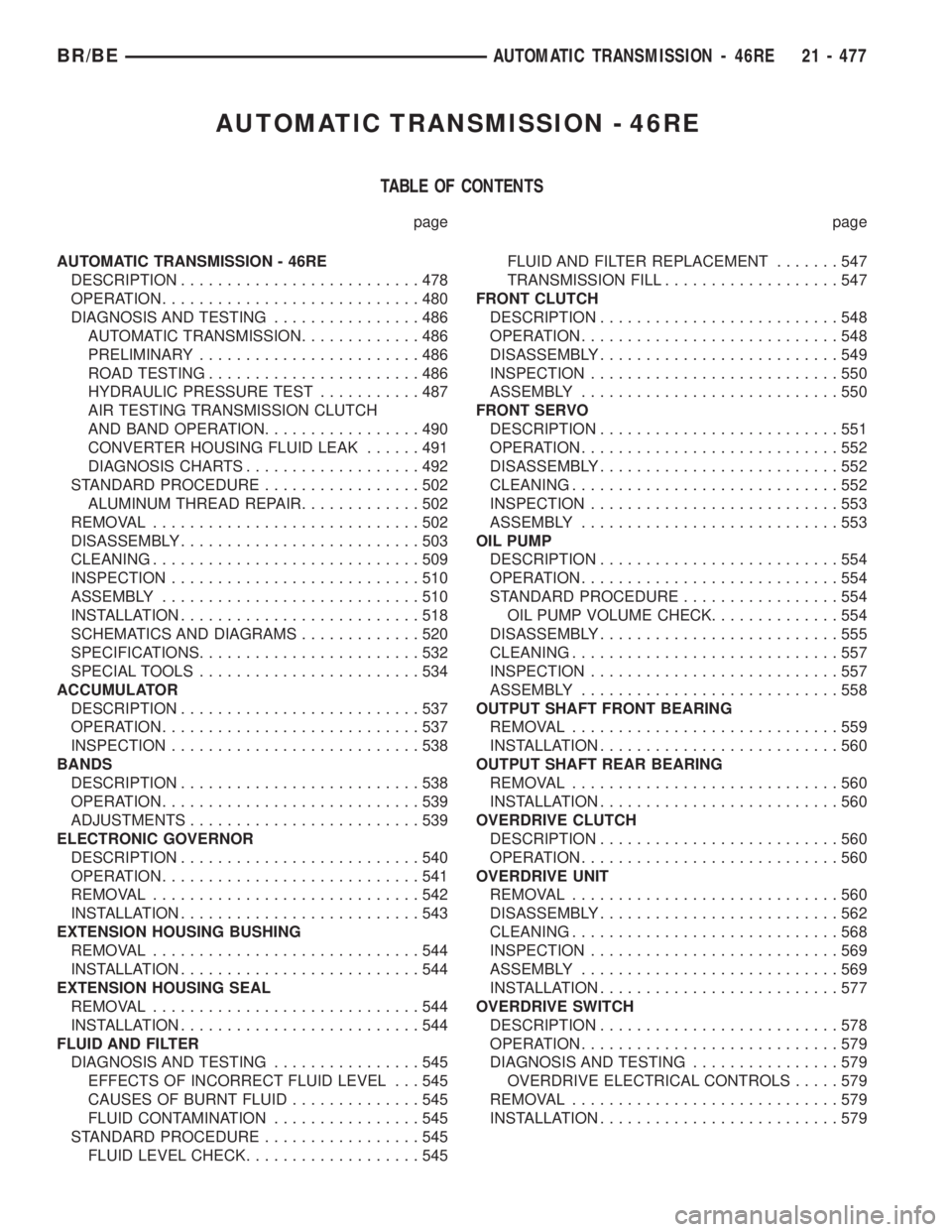
AUTOMATIC TRANSMISSION - 46RE
TABLE OF CONTENTS
page page
AUTOMATIC TRANSMISSION - 46RE
DESCRIPTION..........................478
OPERATION............................480
DIAGNOSIS AND TESTING................486
AUTOMATIC TRANSMISSION.............486
PRELIMINARY........................486
ROAD TESTING.......................486
HYDRAULIC PRESSURE TEST...........487
AIR TESTING TRANSMISSION CLUTCH
AND BAND OPERATION.................490
CONVERTER HOUSING FLUID LEAK......491
DIAGNOSIS CHARTS...................492
STANDARD PROCEDURE.................502
ALUMINUM THREAD REPAIR.............502
REMOVAL.............................502
DISASSEMBLY..........................503
CLEANING.............................509
INSPECTION...........................510
ASSEMBLY............................510
INSTALLATION..........................518
SCHEMATICS AND DIAGRAMS.............520
SPECIFICATIONS........................532
SPECIAL TOOLS........................534
ACCUMULATOR
DESCRIPTION..........................537
OPERATION............................537
INSPECTION...........................538
BANDS
DESCRIPTION..........................538
OPERATION............................539
ADJUSTMENTS.........................539
ELECTRONIC GOVERNOR
DESCRIPTION..........................540
OPERATION............................541
REMOVAL.............................542
INSTALLATION..........................543
EXTENSION HOUSING BUSHING
REMOVAL.............................544
INSTALLATION..........................544
EXTENSION HOUSING SEAL
REMOVAL.............................544
INSTALLATION..........................544
FLUID AND FILTER
DIAGNOSIS AND TESTING................545
EFFECTS OF INCORRECT FLUID LEVEL . . . 545
CAUSES OF BURNT FLUID..............545
FLUID CONTAMINATION................545
STANDARD PROCEDURE.................545
FLUID LEVEL CHECK...................545FLUID AND FILTER REPLACEMENT.......547
TRANSMISSION FILL...................547
FRONT CLUTCH
DESCRIPTION..........................548
OPERATION............................548
DISASSEMBLY..........................549
INSPECTION...........................550
ASSEMBLY............................550
FRONT SERVO
DESCRIPTION..........................551
OPERATION............................552
DISASSEMBLY..........................552
CLEANING.............................552
INSPECTION...........................553
ASSEMBLY............................553
OIL PUMP
DESCRIPTION..........................554
OPERATION............................554
STANDARD PROCEDURE.................554
OIL PUMP VOLUME CHECK..............554
DISASSEMBLY..........................555
CLEANING.............................557
INSPECTION...........................557
ASSEMBLY............................558
OUTPUT SHAFT FRONT BEARING
REMOVAL.............................559
INSTALLATION..........................560
OUTPUT SHAFT REAR BEARING
REMOVAL.............................560
INSTALLATION..........................560
OVERDRIVE CLUTCH
DESCRIPTION..........................560
OPERATION............................560
OVERDRIVE UNIT
REMOVAL.............................560
DISASSEMBLY..........................562
CLEANING.............................568
INSPECTION...........................569
ASSEMBLY............................569
INSTALLATION..........................577
OVERDRIVE SWITCH
DESCRIPTION..........................578
OPERATION............................579
DIAGNOSIS AND TESTING................579
OVERDRIVE ELECTRICAL CONTROLS.....579
REMOVAL.............................579
INSTALLATION..........................579
BR/BEAUTOMATIC TRANSMISSION - 46RE 21 - 477
Page 2113 of 2889
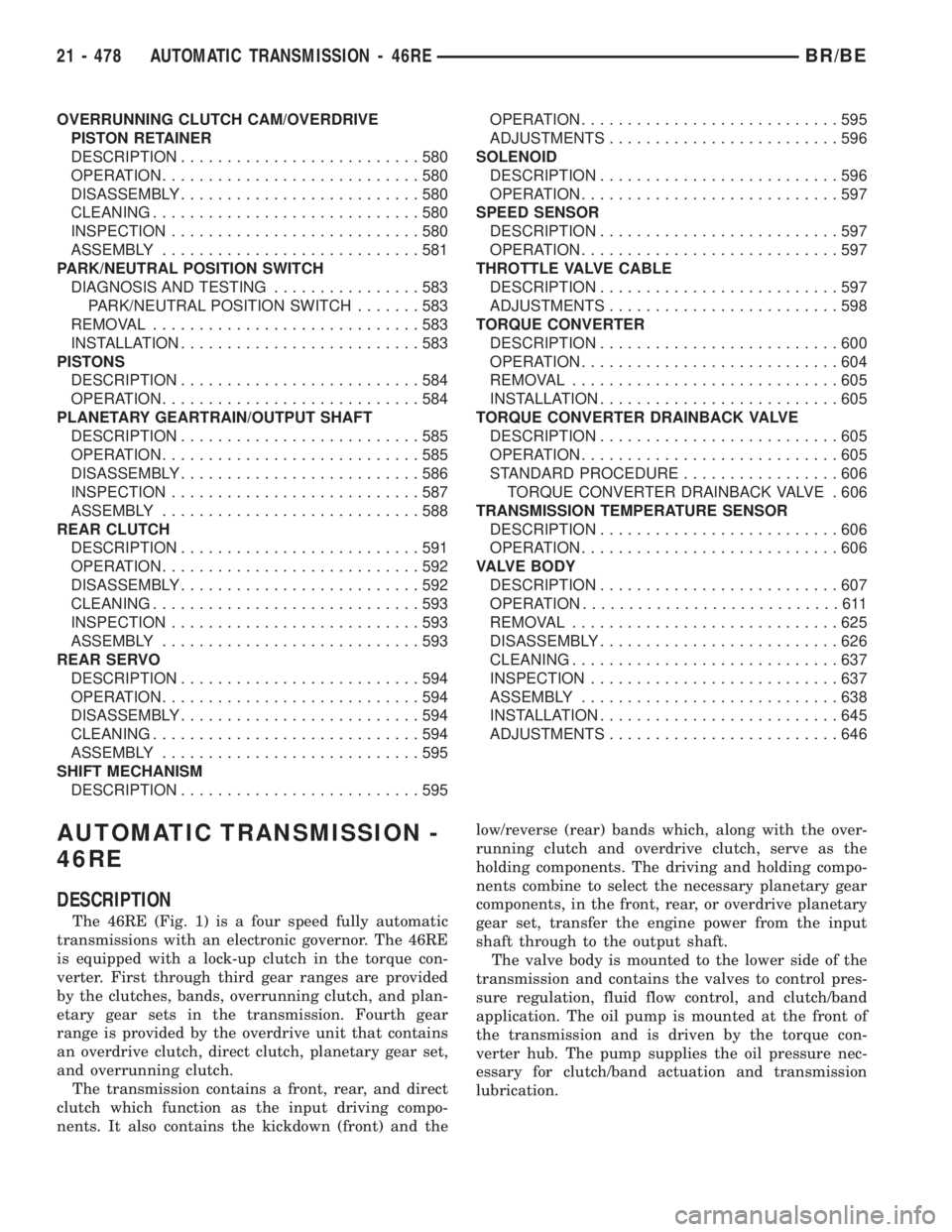
OVERRUNNING CLUTCH CAM/OVERDRIVE
PISTON RETAINER
DESCRIPTION..........................580
OPERATION............................580
DISASSEMBLY..........................580
CLEANING.............................580
INSPECTION...........................580
ASSEMBLY............................581
PARK/NEUTRAL POSITION SWITCH
DIAGNOSIS AND TESTING................583
PARK/NEUTRAL POSITION SWITCH.......583
REMOVAL.............................583
INSTALLATION..........................583
PISTONS
DESCRIPTION..........................584
OPERATION............................584
PLANETARY GEARTRAIN/OUTPUT SHAFT
DESCRIPTION..........................585
OPERATION............................585
DISASSEMBLY..........................586
INSPECTION...........................587
ASSEMBLY............................588
REAR CLUTCH
DESCRIPTION..........................591
OPERATION............................592
DISASSEMBLY..........................592
CLEANING.............................593
INSPECTION...........................593
ASSEMBLY............................593
REAR SERVO
DESCRIPTION..........................594
OPERATION............................594
DISASSEMBLY..........................594
CLEANING.............................594
ASSEMBLY............................595
SHIFT MECHANISM
DESCRIPTION..........................595OPERATION............................595
ADJUSTMENTS.........................596
SOLENOID
DESCRIPTION..........................596
OPERATION............................597
SPEED SENSOR
DESCRIPTION..........................597
OPERATION............................597
THROTTLE VALVE CABLE
DESCRIPTION..........................597
ADJUSTMENTS.........................598
TORQUE CONVERTER
DESCRIPTION..........................600
OPERATION............................604
REMOVAL.............................605
INSTALLATION..........................605
TORQUE CONVERTER DRAINBACK VALVE
DESCRIPTION..........................605
OPERATION............................605
STANDARD PROCEDURE.................606
TORQUE CONVERTER DRAINBACK VALVE . 606
TRANSMISSION TEMPERATURE SENSOR
DESCRIPTION..........................606
OPERATION............................606
VALVE BODY
DESCRIPTION..........................607
OPERATION............................611
REMOVAL.............................625
DISASSEMBLY..........................626
CLEANING.............................637
INSPECTION...........................637
ASSEMBLY............................638
INSTALLATION..........................645
ADJUSTMENTS.........................646
AUTOMATIC TRANSMISSION -
46RE
DESCRIPTION
The 46RE (Fig. 1) is a four speed fully automatic
transmissions with an electronic governor. The 46RE
is equipped with a lock-up clutch in the torque con-
verter. First through third gear ranges are provided
by the clutches, bands, overrunning clutch, and plan-
etary gear sets in the transmission. Fourth gear
range is provided by the overdrive unit that contains
an overdrive clutch, direct clutch, planetary gear set,
and overrunning clutch.
The transmission contains a front, rear, and direct
clutch which function as the input driving compo-
nents. It also contains the kickdown (front) and thelow/reverse (rear) bands which, along with the over-
running clutch and overdrive clutch, serve as the
holding components. The driving and holding compo-
nents combine to select the necessary planetary gear
components, in the front, rear, or overdrive planetary
gear set, transfer the engine power from the input
shaft through to the output shaft.
The valve body is mounted to the lower side of the
transmission and contains the valves to control pres-
sure regulation, fluid flow control, and clutch/band
application. The oil pump is mounted at the front of
the transmission and is driven by the torque con-
verter hub. The pump supplies the oil pressure nec-
essary for clutch/band actuation and transmission
lubrication.
21 - 478 AUTOMATIC TRANSMISSION - 46REBR/BE
Page 2114 of 2889

Fig. 1 46RE Transmission
BR/BEAUTOMATIC TRANSMISSION - 46RE 21 - 479
AUTOMATIC TRANSMISSION - 46RE (Continued)
Page 2115 of 2889
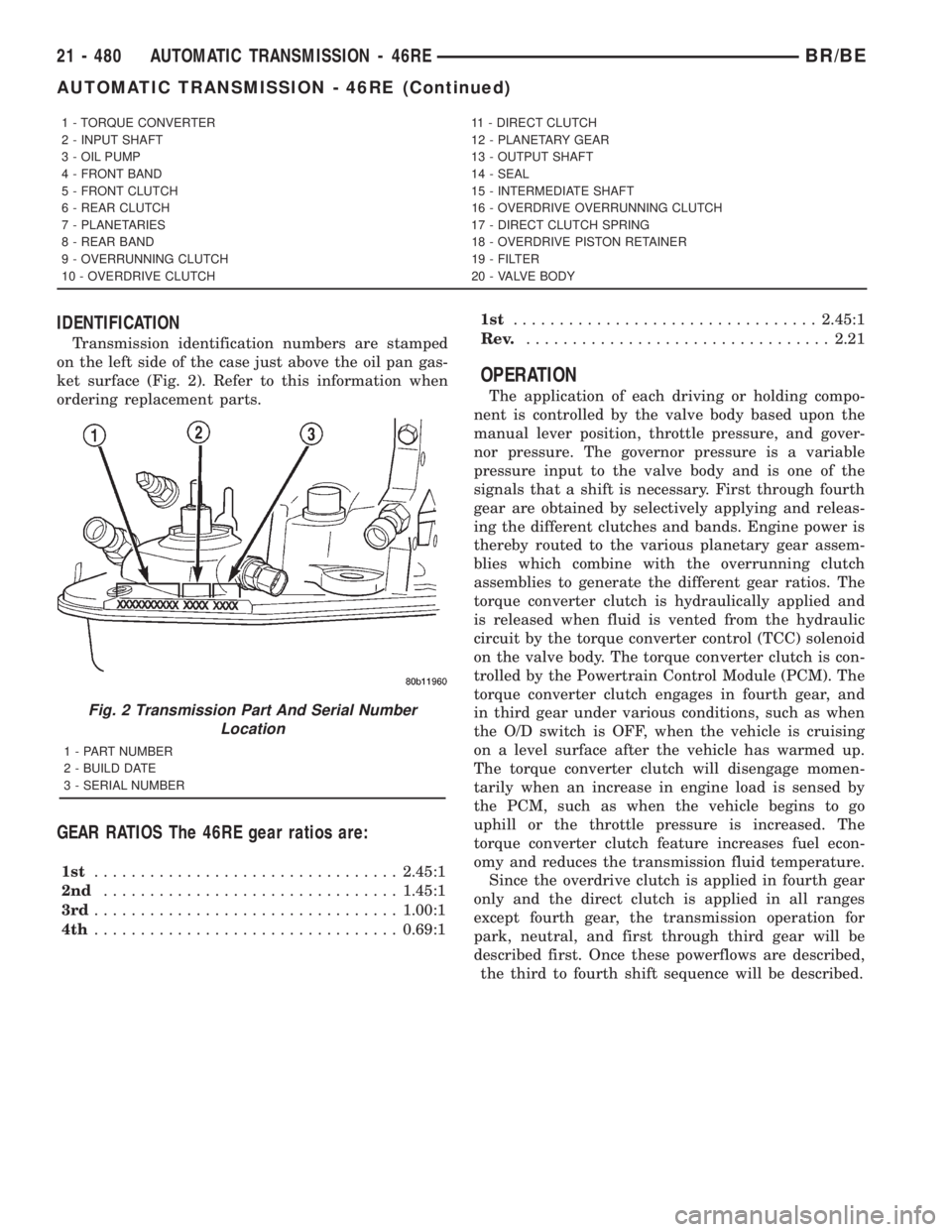
IDENTIFICATION
Transmission identification numbers are stamped
on the left side of the case just above the oil pan gas-
ket surface (Fig. 2). Refer to this information when
ordering replacement parts.
GEAR RATIOS The 46RE gear ratios are:
1st.................................2.45:1
2nd................................1.45:1
3rd.................................1.00:1
4th.................................0.69:11st.................................2.45:1
Rev..................................2.21
OPERATION
The application of each driving or holding compo-
nent is controlled by the valve body based upon the
manual lever position, throttle pressure, and gover-
nor pressure. The governor pressure is a variable
pressure input to the valve body and is one of the
signals that a shift is necessary. First through fourth
gear are obtained by selectively applying and releas-
ing the different clutches and bands. Engine power is
thereby routed to the various planetary gear assem-
blies which combine with the overrunning clutch
assemblies to generate the different gear ratios. The
torque converter clutch is hydraulically applied and
is released when fluid is vented from the hydraulic
circuit by the torque converter control (TCC) solenoid
on the valve body. The torque converter clutch is con-
trolled by the Powertrain Control Module (PCM). The
torque converter clutch engages in fourth gear, and
in third gear under various conditions, such as when
the O/D switch is OFF, when the vehicle is cruising
on a level surface after the vehicle has warmed up.
The torque converter clutch will disengage momen-
tarily when an increase in engine load is sensed by
the PCM, such as when the vehicle begins to go
uphill or the throttle pressure is increased. The
torque converter clutch feature increases fuel econ-
omy and reduces the transmission fluid temperature.
Since the overdrive clutch is applied in fourth gear
only and the direct clutch is applied in all ranges
except fourth gear, the transmission operation for
park, neutral, and first through third gear will be
described first. Once these powerflows are described,
the third to fourth shift sequence will be described.
1 - TORQUE CONVERTER 11 - DIRECT CLUTCH
2 - INPUT SHAFT 12 - PLANETARY GEAR
3 - OIL PUMP 13 - OUTPUT SHAFT
4 - FRONT BAND 14 - SEAL
5 - FRONT CLUTCH 15 - INTERMEDIATE SHAFT
6 - REAR CLUTCH 16 - OVERDRIVE OVERRUNNING CLUTCH
7 - PLANETARIES 17 - DIRECT CLUTCH SPRING
8 - REAR BAND 18 - OVERDRIVE PISTON RETAINER
9 - OVERRUNNING CLUTCH 19 - FILTER
10 - OVERDRIVE CLUTCH 20 - VALVE BODY
Fig. 2 Transmission Part And Serial Number
Location
1 - PART NUMBER
2 - BUILD DATE
3 - SERIAL NUMBER
21 - 480 AUTOMATIC TRANSMISSION - 46REBR/BE
AUTOMATIC TRANSMISSION - 46RE (Continued)
Page 2116 of 2889
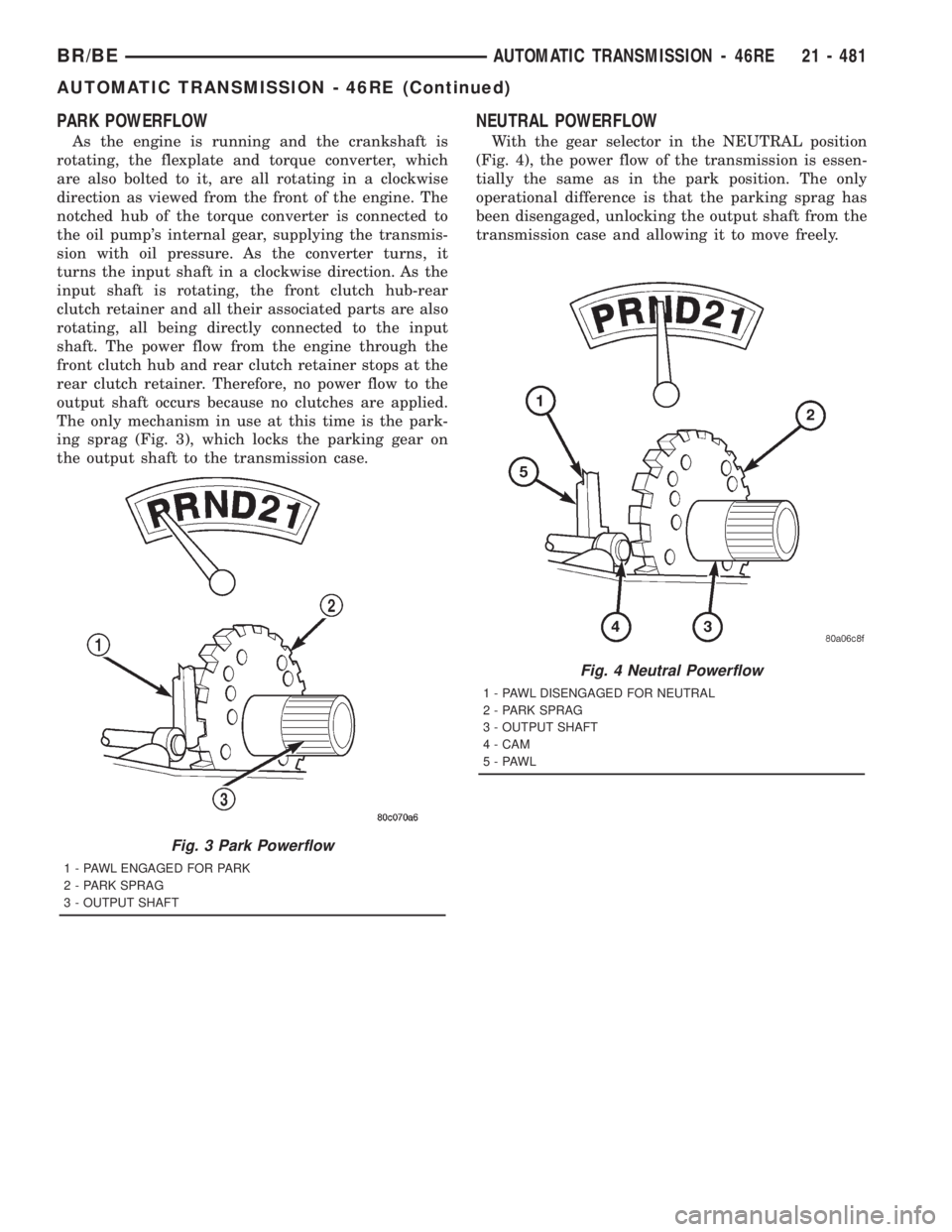
PARK POWERFLOW
As the engine is running and the crankshaft is
rotating, the flexplate and torque converter, which
are also bolted to it, are all rotating in a clockwise
direction as viewed from the front of the engine. The
notched hub of the torque converter is connected to
the oil pump's internal gear, supplying the transmis-
sion with oil pressure. As the converter turns, it
turns the input shaft in a clockwise direction. As the
input shaft is rotating, the front clutch hub-rear
clutch retainer and all their associated parts are also
rotating, all being directly connected to the input
shaft. The power flow from the engine through the
front clutch hub and rear clutch retainer stops at the
rear clutch retainer. Therefore, no power flow to the
output shaft occurs because no clutches are applied.
The only mechanism in use at this time is the park-
ing sprag (Fig. 3), which locks the parking gear on
the output shaft to the transmission case.
NEUTRAL POWERFLOW
With the gear selector in the NEUTRAL position
(Fig. 4), the power flow of the transmission is essen-
tially the same as in the park position. The only
operational difference is that the parking sprag has
been disengaged, unlocking the output shaft from the
transmission case and allowing it to move freely.
Fig. 3 Park Powerflow
1 - PAWL ENGAGED FOR PARK
2 - PARK SPRAG
3 - OUTPUT SHAFT
Fig. 4 Neutral Powerflow
1 - PAWL DISENGAGED FOR NEUTRAL
2 - PARK SPRAG
3 - OUTPUT SHAFT
4 - CAM
5-PAWL
BR/BEAUTOMATIC TRANSMISSION - 46RE 21 - 481
AUTOMATIC TRANSMISSION - 46RE (Continued)
Page 2117 of 2889
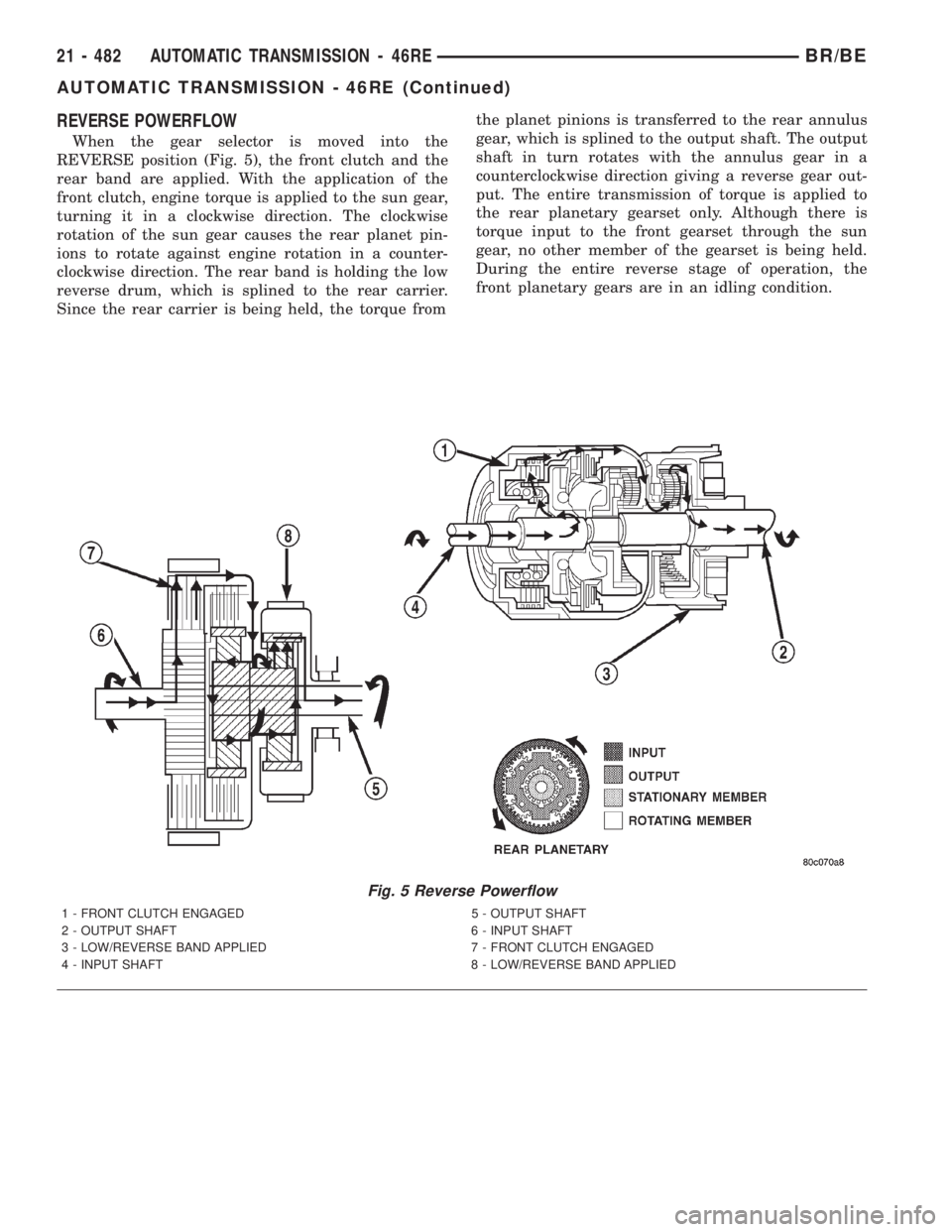
REVERSE POWERFLOW
When the gear selector is moved into the
REVERSE position (Fig. 5), the front clutch and the
rear band are applied. With the application of the
front clutch, engine torque is applied to the sun gear,
turning it in a clockwise direction. The clockwise
rotation of the sun gear causes the rear planet pin-
ions to rotate against engine rotation in a counter-
clockwise direction. The rear band is holding the low
reverse drum, which is splined to the rear carrier.
Since the rear carrier is being held, the torque fromthe planet pinions is transferred to the rear annulus
gear, which is splined to the output shaft. The output
shaft in turn rotates with the annulus gear in a
counterclockwise direction giving a reverse gear out-
put. The entire transmission of torque is applied to
the rear planetary gearset only. Although there is
torque input to the front gearset through the sun
gear, no other member of the gearset is being held.
During the entire reverse stage of operation, the
front planetary gears are in an idling condition.
Fig. 5 Reverse Powerflow
1 - FRONT CLUTCH ENGAGED 5 - OUTPUT SHAFT
2 - OUTPUT SHAFT 6 - INPUT SHAFT
3 - LOW/REVERSE BAND APPLIED 7 - FRONT CLUTCH ENGAGED
4 - INPUT SHAFT 8 - LOW/REVERSE BAND APPLIED
21 - 482 AUTOMATIC TRANSMISSION - 46REBR/BE
AUTOMATIC TRANSMISSION - 46RE (Continued)
Page 2118 of 2889
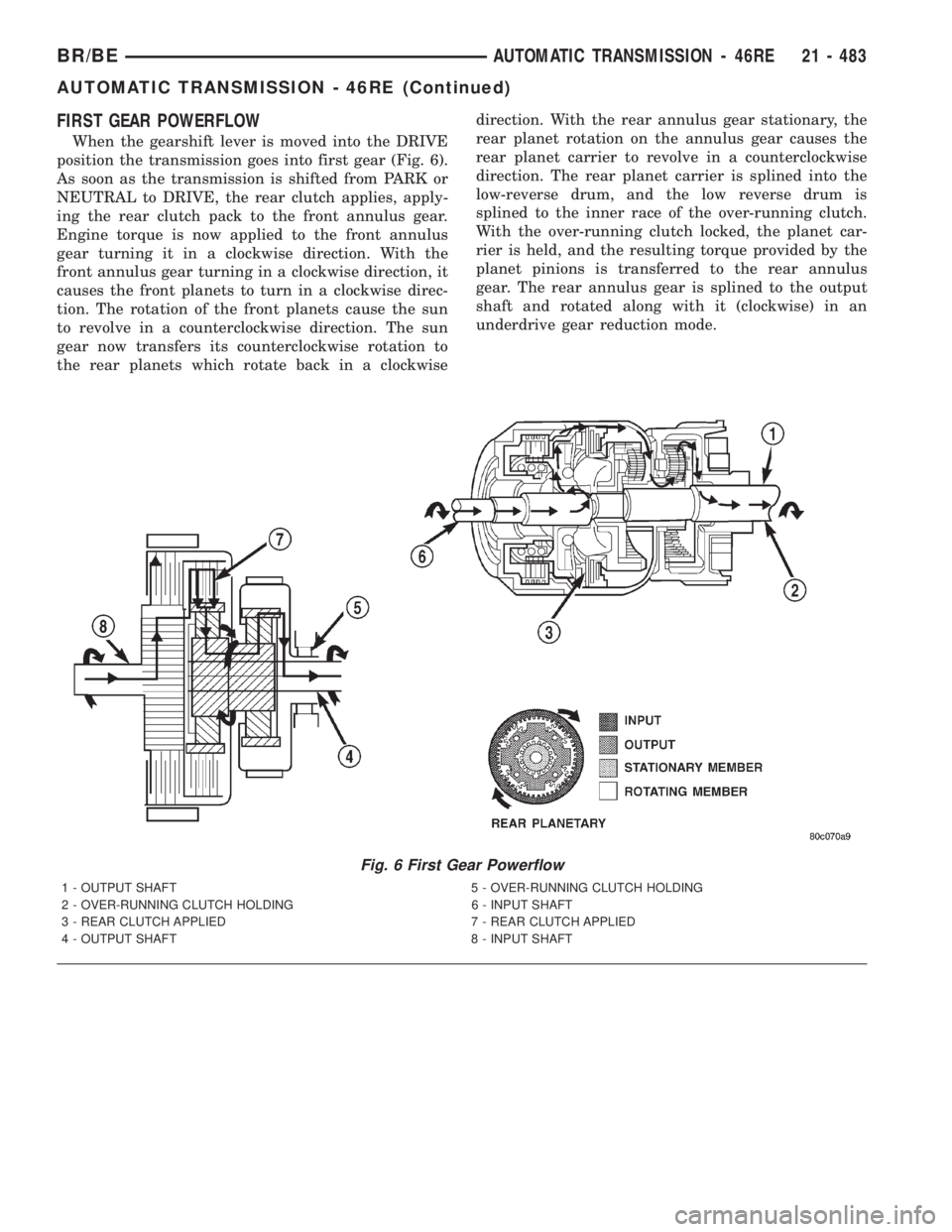
FIRST GEAR POWERFLOW
When the gearshift lever is moved into the DRIVE
position the transmission goes into first gear (Fig. 6).
As soon as the transmission is shifted from PARK or
NEUTRAL to DRIVE, the rear clutch applies, apply-
ing the rear clutch pack to the front annulus gear.
Engine torque is now applied to the front annulus
gear turning it in a clockwise direction. With the
front annulus gear turning in a clockwise direction, it
causes the front planets to turn in a clockwise direc-
tion. The rotation of the front planets cause the sun
to revolve in a counterclockwise direction. The sun
gear now transfers its counterclockwise rotation to
the rear planets which rotate back in a clockwisedirection. With the rear annulus gear stationary, the
rear planet rotation on the annulus gear causes the
rear planet carrier to revolve in a counterclockwise
direction. The rear planet carrier is splined into the
low-reverse drum, and the low reverse drum is
splined to the inner race of the over-running clutch.
With the over-running clutch locked, the planet car-
rier is held, and the resulting torque provided by the
planet pinions is transferred to the rear annulus
gear. The rear annulus gear is splined to the output
shaft and rotated along with it (clockwise) in an
underdrive gear reduction mode.
Fig. 6 First Gear Powerflow
1 - OUTPUT SHAFT 5 - OVER-RUNNING CLUTCH HOLDING
2 - OVER-RUNNING CLUTCH HOLDING 6 - INPUT SHAFT
3 - REAR CLUTCH APPLIED 7 - REAR CLUTCH APPLIED
4 - OUTPUT SHAFT 8 - INPUT SHAFT
BR/BEAUTOMATIC TRANSMISSION - 46RE 21 - 483
AUTOMATIC TRANSMISSION - 46RE (Continued)
Page 2119 of 2889
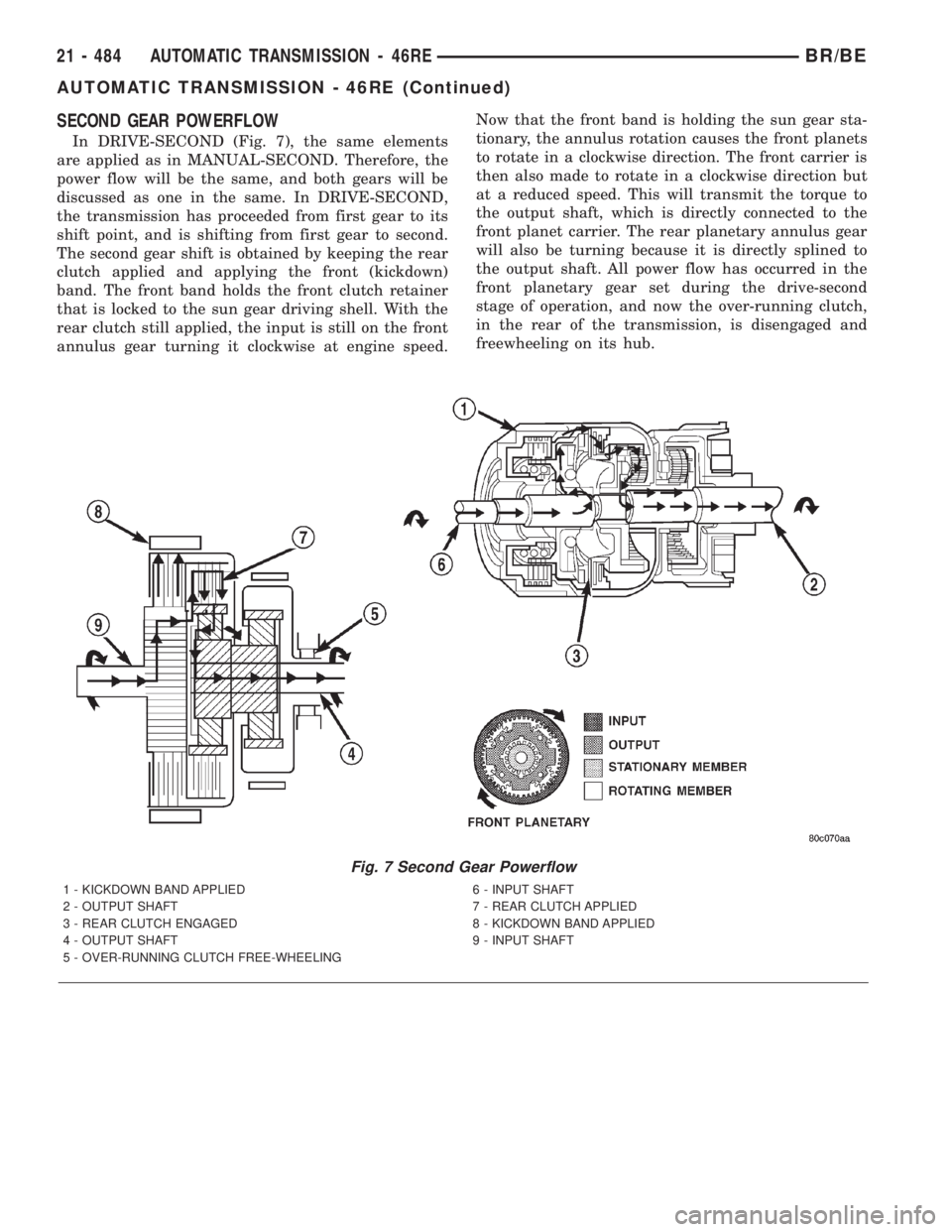
SECOND GEAR POWERFLOW
In DRIVE-SECOND (Fig. 7), the same elements
are applied as in MANUAL-SECOND. Therefore, the
power flow will be the same, and both gears will be
discussed as one in the same. In DRIVE-SECOND,
the transmission has proceeded from first gear to its
shift point, and is shifting from first gear to second.
The second gear shift is obtained by keeping the rear
clutch applied and applying the front (kickdown)
band. The front band holds the front clutch retainer
that is locked to the sun gear driving shell. With the
rear clutch still applied, the input is still on the front
annulus gear turning it clockwise at engine speed.Now that the front band is holding the sun gear sta-
tionary, the annulus rotation causes the front planets
to rotate in a clockwise direction. The front carrier is
then also made to rotate in a clockwise direction but
at a reduced speed. This will transmit the torque to
the output shaft, which is directly connected to the
front planet carrier. The rear planetary annulus gear
will also be turning because it is directly splined to
the output shaft. All power flow has occurred in the
front planetary gear set during the drive-second
stage of operation, and now the over-running clutch,
in the rear of the transmission, is disengaged and
freewheeling on its hub.
Fig. 7 Second Gear Powerflow
1 - KICKDOWN BAND APPLIED 6 - INPUT SHAFT
2 - OUTPUT SHAFT 7 - REAR CLUTCH APPLIED
3 - REAR CLUTCH ENGAGED 8 - KICKDOWN BAND APPLIED
4 - OUTPUT SHAFT 9 - INPUT SHAFT
5 - OVER-RUNNING CLUTCH FREE-WHEELING
21 - 484 AUTOMATIC TRANSMISSION - 46REBR/BE
AUTOMATIC TRANSMISSION - 46RE (Continued)
Page 2120 of 2889
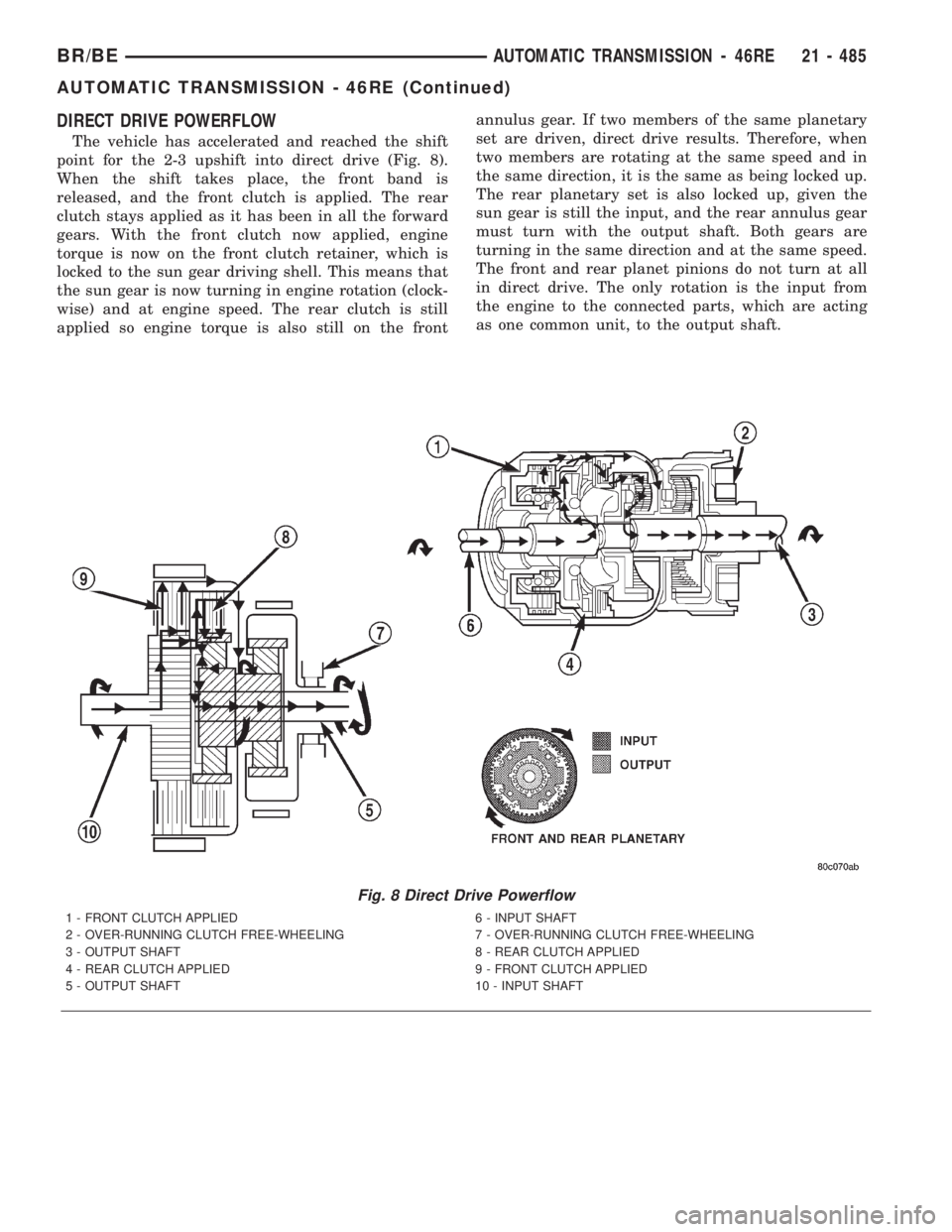
DIRECT DRIVE POWERFLOW
The vehicle has accelerated and reached the shift
point for the 2-3 upshift into direct drive (Fig. 8).
When the shift takes place, the front band is
released, and the front clutch is applied. The rear
clutch stays applied as it has been in all the forward
gears. With the front clutch now applied, engine
torque is now on the front clutch retainer, which is
locked to the sun gear driving shell. This means that
the sun gear is now turning in engine rotation (clock-
wise) and at engine speed. The rear clutch is still
applied so engine torque is also still on the frontannulus gear. If two members of the same planetary
set are driven, direct drive results. Therefore, when
two members are rotating at the same speed and in
the same direction, it is the same as being locked up.
The rear planetary set is also locked up, given the
sun gear is still the input, and the rear annulus gear
must turn with the output shaft. Both gears are
turning in the same direction and at the same speed.
The front and rear planet pinions do not turn at all
in direct drive. The only rotation is the input from
the engine to the connected parts, which are acting
as one common unit, to the output shaft.
Fig. 8 Direct Drive Powerflow
1 - FRONT CLUTCH APPLIED 6 - INPUT SHAFT
2 - OVER-RUNNING CLUTCH FREE-WHEELING 7 - OVER-RUNNING CLUTCH FREE-WHEELING
3 - OUTPUT SHAFT 8 - REAR CLUTCH APPLIED
4 - REAR CLUTCH APPLIED 9 - FRONT CLUTCH APPLIED
5 - OUTPUT SHAFT 10 - INPUT SHAFT
BR/BEAUTOMATIC TRANSMISSION - 46RE 21 - 485
AUTOMATIC TRANSMISSION - 46RE (Continued)